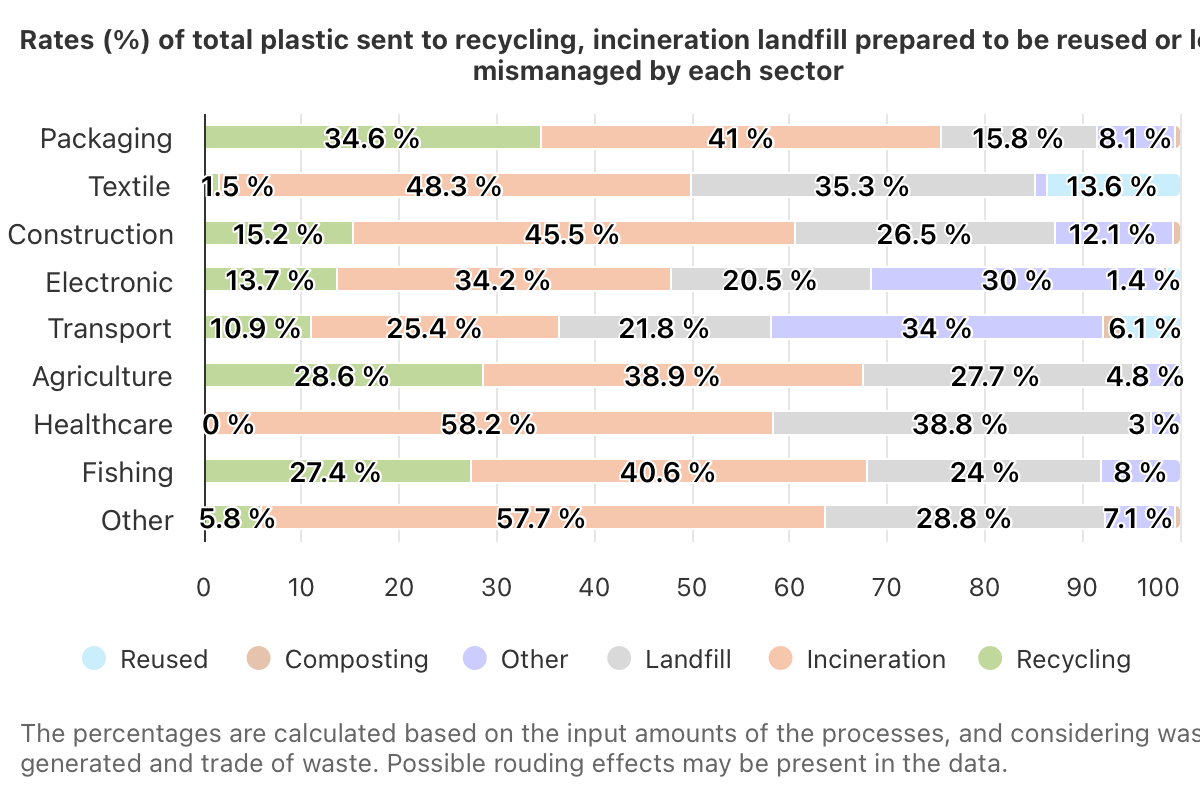Production, consumption, and insufficient recycling reveal that current efforts, while important, aren’t breaking through the biggest barriers. A new report from the Joint Research Centre (JRC) maps out plastic flows across the EU – and raises a bigger question: can the system ever really reach environmental neutrality?
A snapshot of Europe’s plastic use
In 2022, EU countries consumed 62.8 million tonnes of plastic – that’s about 140 kilograms per person. A massive 92% of this was produced within the EU itself. Imports are led by textiles, which account for 32.4% of all plastic entering the Union.
The entire plastic lifecycle – from production to disposal – generated over 252 million tonnes of CO₂ emissions, with production alone responsible for 58%. To put that in perspective: if the EU plastic sector were its own country, it would rank as the fifth-largest emitter in Europe. And the future looks even more worrying: according to the OECD, global plastic consumption is set to double by 2060.

European Commission: https://joint-research-centre.ec.europa.eu/jrc-news-and-updates/can-plastics-sector-become-more-sustainable-2025-08-11_en
Recycling vs. reality
The EU produced 42.5 million tonnes of plastic waste in 2022, and around 80% of it was burned or dumped in landfills. Recycling has expanded fivefold since 1996, but the actual recycling rate hovers around 20%. The problem isn’t just infrastructure – it’s the quality of collection and sorting.
Packaging, which creates almost half of all plastic waste, performs relatively better, with nearly 35% recycled. But textiles are a disaster: only 1.5% are recycled, with the rest ending up incinerated or buried. Poor collection systems mean valuable materials are lost forever.
The hidden cost: environmental leakage
Roughly 3.7 million tonnes of plastic – about 6% of EU consumption – ended up directly in the environment. Nearly half of this comes from everyday use, like littered packaging, tyre wear, or washing synthetic clothes. Another 38% leaks during waste management, especially through burning and landfilling.
Most of this pollution enters soil, but about 700,000 tonnes flow into rivers, lakes, and seas. This isn’t just an ecological issue – it’s also an economic one, raising costs for clean-up, farming, fishing, and even public health.
Where do we go from here?
Between 2018 and 2022, EU plastic production fell, partly due to oil price fluctuations and global overcapacity. The JRC report suggests that shifting faster toward plastics made from waste and biomass could cut emissions and reduce dependence on fossil fuels.
Bioplastics are becoming more common in packaging, but they’re still niche. At the current pace, their impact will only be felt decades from now. And it’s still unclear if bioplastics are truly better than traditional plastics once the full lifecycle is considered.
Chemical recycling: a future fix or false promise?
The report highlights chemical recycling as a potential game-changer. Unlike mechanical recycling, it can handle plastics that are otherwise impossible to reuse. But it’s expensive, energy-intensive, and could create new environmental problems.
Improving waste collection and sorting – especially in low-recycling sectors like textiles – could unlock far more recycling potential. But this requires investment, better infrastructure, and changes in consumer habits. Laws alone won’t make it happen overnight.
Europe’s ambitions vs. global reality
The EU wants to set the global standard for plastic waste management. But in reality, the plastic market is global – and imports, especially textiles, push part of the environmental cost outside Europe. Without binding international agreements, even the EU’s ambitious goals may have limited impact.
So here’s the big strategic question: should the EU focus on drastically cutting its own plastic use, or on pushing for global agreements and producer responsibility systems? Without a clear direction, European policy risks staying a patchwork of initiatives rather than a united strategy.
Written by
Shape the conversation
Do you have anything to add to this story? Any ideas for interviews or angles we should explore? Let us know if you’d like to write a follow-up, a counterpoint, or share a similar story.
